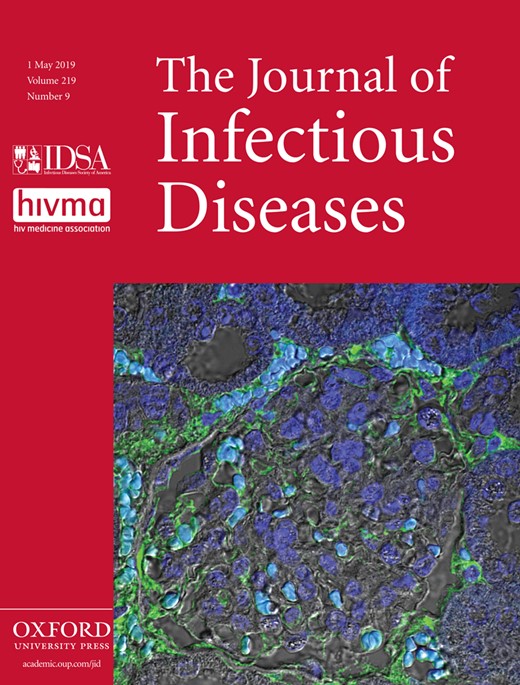
Cover image

Volume 219, Issue 9, 1 May 2019
EDITORIAL COMMENTARIES
Outbreak Epidemiology: One of Many New Frontiers of Norovirus Biology
The Immune Checkpoint Protein Programmed Death 1 During HIV Infection in Children: Clinical Relevance and Beyond
REVIEW ARTICLE
Undernutrition and Tuberculosis: Public Health Implications
Undernutrition, which affects almost 800 million people worldwide, impairs innate and adaptive immune responses against Mycobacterium tuberculosis infection. This narrative review describes the effect of undernutrition on the immune response, vaccine response, and tuberculosis incidence, severity, and treatment outcomes.
MAJOR ARTICLES AND BRIEF REPORTS
VIRUSES
The Norovirus Epidemiologic Triad: Predictors of Severe Outcomes in US Norovirus Outbreaks, 2009–2016
Acute norovirus outbreaks reported to the National Outbreak Reporting System in 2009–2016 were linked to laboratory-confirmed norovirus outbreaks reported to CaliciNet. Severe outcomes more frequently occurred in norovirus outbreaks caused by GII.4 and those in healthcare settings.
Sexually Acquired Hepatitis C Infection in HIV-Uninfected Men Who Have Sex With Men Using Preexposure Prophylaxis Against HIV
We report 15 incident hepatitis C virus (HCV) infections among 14 HIV-uninfected men who have sex with men (MSM) on preexposure prophylaxis (PrEP). Most were asymptomatic and detected on routine screening, underscoring the importance of HCV surveillance among PrEP-using MSM.
Prostasin Impairs Epithelial Growth Factor Receptor Activation to Suppress Dengue Virus Propagation
Clinically, prostasin expression and DENV-2 RNA copy number showed a significant negative correlation. Prostasin overexpression reduced DENV-2 propagation in vivo and in vitro. The molecular mechanism of prostasin against DENV-2 was due to suppression of EGFR/Akt/NF-κB–mediated cyclooxygenase-2 expression.
Trends in the Prevalence of Anogenital Warts Among Patients at Sexually Transmitted Disease Clinics—Sexually Transmitted Disease Surveillance Network, United States, 2010–2016
Data from US Sexually Transmitted Disease Surveillance Network clinics revealed significant declines during 2010–2016 in prevalences of anogenital warts among women aged <40 years, men aged <40 years who have sex with women only, and men of any age who have sex with men.
Blood Viral Load in Symptomatic Congenital Cytomegalovirus Infection
In symptomatic congenital CMV infection, higher blood viral load before therapy correlates with thrombocytopenia, transaminitis, and CNS involvement but has little predictive value for long-term outcome. Early and sustained viral suppression during therapy may correlate with a better hearing outcome.
PATHOGENESIS AND HOST RESPONSE
Differential Pathogen-Specific Immune Reconstitution in Antiretroviral Therapy-Treated Human Immunodeficiency Virus-Infected Children
Immune activation, immune exhaustion, and T-cell responses were studied in HIV-infected children before and after 1 year of ART. Changes in T-cell functionality were observed that differed by pathogen-specificity and were correlated with alterations of PD-1 expression and memory phenotype.
Parvovirus B19V Nonstructural Protein NS1 Induces Double-Stranded Deoxyribonucleic Acid Autoantibodies and End-Organ Damage in Nonautoimmune Mice
Inoculation of normal mice with apoptotic bodies, generated by parvovirus B19V helicase NS1 expression, induces dsDNA antibodies and organ damage. This study provides proof of concept that viral modification of host cell DNA can lead to autoimmunity.
Chemokine-Regulated Recruitment of Antigen-Specific T-Cell Subpopulations to the Liver in Acute and Chronic Hepatitis C Infection
Analysis of mononuclear cells from subjects with acute and chronic hepatitis C reveals that antigen-specific CD8 T cells preferentially express CXCR3. As CXCL10 is heavily expressed in the hepatitis C-infected liver, the CXCR3-CXCL10 trafficking pathway appears critical for recruitment.
BACTERIA
Bacteriophage Therapy Increases Complement-Mediated Lysis of Bacteria and Enhances Bacterial Clearance After Acute Lung Infection With Multidrug-Resistant Pseudomonas aeruginosa
Persistence of Moraxella catarrhalis in Chronic Obstructive Pulmonary Disease and Regulation of the Hag/MID Adhesin
Moraxella catarrhalis persists in COPD with profound clinical and pathogenetic consequences. Most strains express the major surface antigen Hag/MID on acquisition and then shut off expression, suggesting that Hag/MID is critical for initial colonization and cessation of expression facilitates persistence.
HIV/AIDS
Impact of HLA Allele-KIR Pairs on HIV Clinical Outcome in South Africa
Association between HLA-KIR pair and HIV disease outcome among South African HIV patients was statistically analyzed, and HLA-C*16:01-KIR2DL3 was identified as a disease-susceptible pair, suggested existence of KIR-mediated innate immunity effecting on HIV disease progression.
PARASITES
Pharmacokinetics and In Vivo Efficacy of Pyrazolopyrimidine, Pyrrolopyrimidine, and 5-Aminopyrazole-4-Carboxamide Bumped Kinase Inhibitors against Toxoplasmosis
This manuscript describes new bumped kinase inhibitors with pyrazolopyrimidine, 5-aminopyrazole-4-carboxamide, and pyrrolopyrimidine scaffolds that are highly effective against toxoplasmosis in systemic and brain infection models, and possess diverse pharmacokinetic properties that allow for once-daily oral administration.
The Effect of Helminths on Granulocyte Activation: A Cluster-Randomized Placebo-Controlled Trial in Indonesia
This study shows that anthelmintic treatment decreased eosinophil numbers, but did not significantly change the activation status nor responsiveness of either circulating eosinophils or neutrophils, as assessed in a placebo-controlled trial conducted in a rural area in Indonesia.
Artemisinin Resistance and Stage Dependency of Parasite Clearance in Falciparum Malaria
The effect of parasite stage of development on the parasite clearance curve was investigated in areas affected by artemisinin resistance. Parasite stage shapes the early part of the clearance curve and also influences the subsequent log-linear decline.
Diagnostic Performance of Conventional and Ultrasensitive Rapid Diagnostic Tests for Malaria in Febrile Outpatients in Tanzania
Ultrasensitive rapid diagnostic tests (RDTs) for malaria, designed for Plasmodium falciparum elimination campaigns, may be used off label in clinical practice. The diagnostic performances of ultrasensitive and conventional RDTs were similar in febrile Tanzanian outpatients, which is explained by the underlying HRP2 concentration and parasite density distributions.
Contribution of Asymptomatic Plasmodium Infections to the Transmission of Malaria in Kayin State, Myanmar
This study demonstrates the major contribution of asymptomatic low-density Plasmodium infections to the transmission of malaria in Southeast Asian settings. Mass drug administration with dihydroartemisinin-piperaquine can interrupt malaria transmission rapidly in areas where the prevalence of asymptomatic infection is high.



